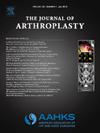极轴角度 "减小与全髋关节置换术后的不稳定性有关:在侧坐位X光片上评估功能性组件位置的新方法。
IF 3.4
2区 医学
Q1 ORTHOPEDICS
引用次数: 0
摘要
背景:有关髋关节不稳定性的研究主要集中在建立仰卧姿势下组合组件位置的 "安全 "范围,或根据髋关节与脊柱的关系确定髋臼组件的功能性位置。全髋关节置换术(THA)组件的一个新角度--极轴角度(PAA)描述了两个组件的同心度,可在不稳定性风险较大的功能体位(如坐位)下进行评估。本研究的目的是比较术后脱位患者与未发生脱位的匹配对照组在功能体位下的极轴角度:方法: 我们在一个机构数据库中搜索了初次 THA 术后发生脱位的患者。脱位患者组包括术后全长立位和坐位侧位X光片患者。按照年龄、体重指数(BMI)、性别和髋关节-脊柱分类,以2:1的比例匹配非脱位患者对照组。颈部角度、髋臼前倾角和极轴角度(PAA)的影像学测量分别由两名经过培训的盲人进行:结果:与对照组(n = 74)相比,脱位者组(n = 37)的侧坐颈角和侧坐极轴角测量值明显较低(分别为 23 度对 33 度,P < 0.001;74 度对 83 度,P = 0.012)。站姿与坐姿之间的极轴和颈部角度变化也存在显著差异(P < 0.001 和 P < 0.001)。在比较脱位者组中活动脊柱与僵硬脊柱的患者时,髋臼角、颈部角或极轴角均无差异。在不同组别中,颈部角度对极轴角度的影响呈线性趋势:结论:在年龄、性别、体重指数和髋关节脊柱分类相匹配的情况下,术后不稳定的患者在坐位侧位片上的极轴角度明显较低。此外,较低的坐位极轴角更大程度上是由功能性股骨内翻的减少造成的,这强调了功能性股骨内翻对全髋关节置换术稳定性的作用。本文章由计算机程序翻译,如有差异,请以英文原文为准。
Decreased “Polar Axis Angle” is Associated With Instability After Total Hip Arthroplasty: A New Method to Assess Functional Component Position on Lateral-Seated Radiographs
Background
Research on hip instability has focused on establishing “safe” ranges of combined component position in supine posture or functional placement of the acetabular component based on the hip-spine relationship. A new angle, the polar axis angle (PAA), of the total hip arthroplasty (THA) components describes the concentricity of both components and can be evaluated in functional positions that confer a greater risk of instability (ie, sitting). The goal of this study was to compare the PAA in functional positions between patients who experienced a postoperative dislocation and a matched control group who did not have a dislocation.
Methods
An institutional database was searched for patients experiencing a dislocation after primary THA. Patients who had postoperative full-length standing and lateral-seatedradiographs were included in the dislocator group. A control group of nondislocator patients was matched 2:1 by age, body mass index, sex, and hip-spine classification. Radiographic measurements of the neck angle, acetabular ante-inclination, and PAA were performed by 2 separate blinded, trained reviewers.
Results
The lateral-seated neck angle and lateral-seated PAA measurements were significantly lower in the dislocator groups (n = 37) than the control group (n = 74) (23 versus 33 degrees, P < .001; 74 versus 83 degrees, P = .012, respectively). Significant differences were also observed in changes in the polar axes and neck angles between standing and seated positions (P < .001 and P < .001, respectively). When comparing patients who have mobile spines versus stiff spines within the dislocator group, there were no differences in the acetabular, neck, or PAAs. The effect of neck angle on the PAA showed a linear trend across cohorts.
Conclusions
Patients who experience postoperative instability have a significantly lower PAA on lateral-seated radiographs when matched for age, sex, body mass index, and hip-spine classification. In addition, the lower seated PAA is driven more strongly by decreased functional femoral anteversion, which emphasizes the role of functional femoral version on stability in THA.
求助全文
通过发布文献求助,成功后即可免费获取论文全文。
去求助
来源期刊

Journal of Arthroplasty
医学-整形外科
CiteScore
7.00
自引率
20.00%
发文量
734
审稿时长
48 days
期刊介绍:
The Journal of Arthroplasty brings together the clinical and scientific foundations for joint replacement. This peer-reviewed journal publishes original research and manuscripts of the highest quality from all areas relating to joint replacement or the treatment of its complications, including those dealing with clinical series and experience, prosthetic design, biomechanics, biomaterials, metallurgy, biologic response to arthroplasty materials in vivo and in vitro.
 求助内容:
求助内容: 应助结果提醒方式:
应助结果提醒方式:


